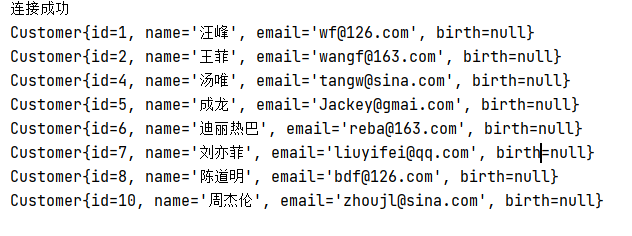JDBC
package test; import bean.Customer; import org.junit.jupiter.api.Test; import util.JDBCUtils; import java.lang.reflect.Field; import java.lang.reflect.InvocationTargetException; import java.sql.*; import java.util.ArrayList; import java.util.List; /** * @ClassName PreparedStatementQueryTest * @Description 使用PreparedStatement实现对不同表的查询操作 * @Author Administrator * @Date 2022/4/8 14:29 * @Version 1.0 **/ public class PreparedStatementQueryTest { @Test public void testGetForList(){ String sql = "select id,name,email from customers where id < ?"; List<Customer> list = getForList(Customer.class, sql, 12); list.forEach(System.out::println);//方法引用 } public <T> List<T> getForList(Class<T> clazz,String sql,Object...args){ Connection connection = JDBCUtils.getConnection(); PreparedStatement preparedStatement = null; ResultSet resultSet = null; //执行查询操作 try { preparedStatement = connection.prepareStatement(sql); //填充占位符 for (int i = 1; i <= args.length; i++) { preparedStatement.setObject(i, args[i-1]);//将指定字段赋给 preparedStatement 填充占位符 } //获取结果集 resultSet = preparedStatement.executeQuery(); //获取结果集元数据 ResultSetMetaData metaData = resultSet.getMetaData();//获取结果集的元数据 //通过结果集元数据获取列个数 int columnCount = metaData.getColumnCount();//通过元数据 获取结果集的列数量 //创建集合对象 ArrayList<T> list = new ArrayList<>(); while (resultSet.next()){ //Customer customer = new Customer(); T t = clazz.getDeclaredConstructor().newInstance(); //处理结果集的一行数据中的每一列,给t对象指定的属性赋值 for (int i = 0; i < columnCount; i++) { //获取每个指定列的列值 Object columnValue = resultSet.getObject(i + 1); //获取每个指定列的列名 -- 不推荐使用 //String columnName = metaData.getColumnName(i + 1); //获取每个指定列的别名 -- 推荐使用 //通过结果集元数据获取列别名 String columnLabel = metaData.getColumnLabel(i+1); //通过反射 //给customer对象的指定 columnName属性赋值为 columnValue : 通过 反射 Field field = clazz.getDeclaredField(columnLabel); field.setAccessible(true); field.set(t,columnValue); } list.add(t); } return list; } catch (SQLException | NoSuchFieldException | IllegalAccessException | InstantiationException | InvocationTargetException | NoSuchMethodException throwables) { throwables.printStackTrace(); } finally { JDBCUtils.closeResource(connection,preparedStatement,resultSet);//关闭资源 } return null; } @Test public void testGetInstance(){ String sql = "select id,name,email from customers where id = ?"; Customer customer = getInstance(Customer.class, sql, 12); System.out.println(customer); String sql1 = "select id,name,password from user where id = ?"; User user = getInstance(User.class, sql1, 1); System.out.println(user); } /* * * @Author zhongweiLee * @Description 通用查询操作,对不同的表进行查询, 使用泛型方法 * @Date 14:30 2022/4/8 * @Parm [Class<T> clazz,String sql,Object...args] * @return <T> T **/ public <T> T getInstance(Class<T> clazz,String sql,Object...args){ Connection connection = JDBCUtils.getConnection(); PreparedStatement preparedStatement = null; ResultSet resultSet = null; //执行查询操作 try { preparedStatement = connection.prepareStatement(sql); //填充占位符 for (int i = 1; i <= args.length; i++) { preparedStatement.setObject(i, args[i-1]);//将指定字段赋给 preparedStatement 填充占位符 } //获取结果集 resultSet = preparedStatement.executeQuery(); //获取结果集元数据 ResultSetMetaData metaData = resultSet.getMetaData();//获取结果集的元数据 //通过结果集元数据获取列个数 int columnCount = metaData.getColumnCount();//通过元数据 获取结果集的列数量 if (resultSet.next()){ //Customer customer = new Customer(); T t = clazz.getDeclaredConstructor().newInstance(); for (int i = 0; i < columnCount; i++) { //获取每个指定列的列值 Object columnValue = resultSet.getObject(i + 1); //获取每个指定列的列名 -- 不推荐使用 //String columnName = metaData.getColumnName(i + 1); //获取每个指定列的别名 -- 推荐使用 //通过结果集元数据获取列别名 String columnLabel = metaData.getColumnLabel(i+1); //通过反射 //给customer对象的指定 columnName属性赋值为 columnValue : 通过 反射 Field field = clazz.getDeclaredField(columnLabel); field.setAccessible(true); field.set(t,columnValue); } // System.out.println(t); return t; } } catch (SQLException | NoSuchFieldException | IllegalAccessException | InstantiationException | InvocationTargetException | NoSuchMethodException throwables) { throwables.printStackTrace(); } finally { JDBCUtils.closeResource(connection,preparedStatement,resultSet);//关闭资源 } return null; } }

本文来自博客园,作者:{zhongweiLeex},转载请注明原文链接:{https://www.cnblogs.com/lzw6/}




 浙公网安备 33010602011771号
浙公网安备 33010602011771号